Radeon RX Vega Unveiled: AMD Announces $499 RX Vega 64 & $399 RX Vega 56, Launching August 14th
by Ryan Smith on July 30, 2017 10:30 PM EST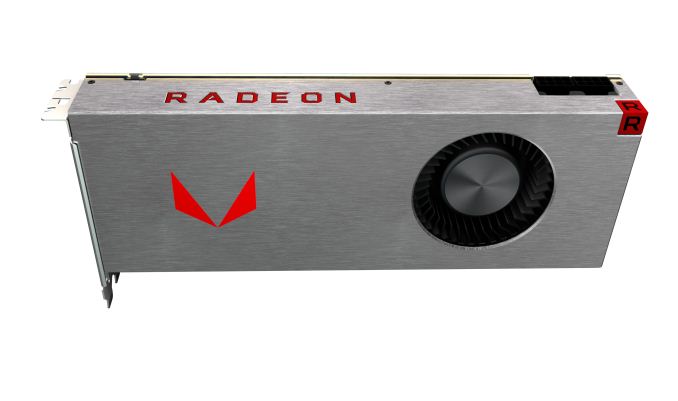
At this point, one must give credit to AMD for their marketing program for the Radeon RX Vega. The company has opted to drip feed information over many months, and as a result this has kept the public interested in the architecture and consumer RX Vega cards. Since it was by name back in the spring of 2016, we’ve had architecture previews, product teasers, and even a new Frontier Editions to tide us over. Suffice it to say, there’s a great deal of fascination in finally seeing the products AMD has been beating the drums about for so long.
To that end, there’s good news today and there’s bad news today. In the interest of expediency, I may as well start with the bad news: today is not the launch day for the Radeon RX Vega. In fact, only right before this embargo expired did AMD even announce a launch date: August 14th. So for reviews, performance analyses, and of course purchasing, everyone will have to hold on just a bit longer.
The good news then is that even if today isn’t the Radeon RX Vega launch, AMD is finally making significant progress towards it by announcing the cards, the specifications, and the pricing. Gamers may not be able to buy the cards quite yet, but everyone is going to have some time to size up the situation before the proper launch of the cards next month. Overall this situation is very similar to the unveiling of the Radeon R9 290 series, where AMD announced the cards at a product showcase before launching them the following month.
So without further ado, let’s dive into the Radeon RX Vega family of cards and their specifications.
| AMD Radeon RX Series Specification Comparison | ||||||
| AMD Radeon RX Vega 64 Liquid | AMD Radeon RX Vega 64 | AMD Radeon RX Vega 56 | AMD Radeon R9 Fury X | |||
| Stream Processors | 4096 (64 CUs) |
4096 (64 CUs) |
3585 (56 CUs) |
4096 (64 CUs) |
||
| Texture Units | 256 | 256 | 224 | 256 | ||
| ROPs | 64 | 64 | 64? | 64 | ||
| Base Clock | 1406MHz | 1247MHz | 1156MHz | N/A | ||
| Boost Clock | 1677MHz | 1546MHz | 1471MHz | 1050MHz | ||
| Memory Clock | 1.89Gbps HBM2 | 1.89Gbps HBM2 | 1.6Gbps HBM2 | 1Gbps HBM | ||
| Memory Bus Width | 2048-bit | 2048-bit | 2048-bit | 4096-bit | ||
| VRAM | 8GB | 8GB | 8GB | 4GB | ||
| Transistor Count | 12.5B | 12.5B | 12.5B | 8.9B | ||
| Board Power | 345W | 295W | 210W | 275W (Typical) |
||
| Manufacturing Process | GloFo 14nm | GloFo 14nm | GloFo 14nm | TSMC 28nm | ||
| Architecture | GCN 5 | GCN 5 | GCN 5 | GCN 3 | ||
| GPU | Vega 10 | Vega 10 | Vega 10 | Fiji | ||
| Launch Date | 08/14/2017 | 08/14/2017 | 08/14/2017 | 06/24/2015 | ||
| Launch Price | $699* | $499/599* | $399/499* | $649 | ||
All told, AMD will be releasing 3 different RX Vega cards. All 3 cards are based on the same GPU, Vega 10, which powers the already released Radeon Vega Frontier Edition. So if you’re familiar with that card, then you should have an idea of what to expect here.
The top of AMD’s lineup is the Radeon RX Vega 64 Liquid Cooled Edition. This is a fully enabled Vega 10 card and it has the highest clockspeeds and highest power requirements of the stack. All told, this is 64 CUs, 64 ROPs, boosting to 1677MHz, and paired with 8GB of HBM2 memory clocked at 1.89Gbps. Typical board power for the card is rated at 345W. To cool such a card, you of course will want liquid cooling, and living up to the name the card, AMD has included just that, thanks to a pump and 120mm radiator.
The second member of AMD’s lineup is the shorter-named vanilla Radeon RX Vega 64. Unlike its liquid cooled predecessor, this is a traditional blower-type air cooled card. And for the purposes of AMD’s product stack, the company is treating the vanilla Vega 64 as the “baseline” card for the Vega 64 family. This means that the company’s performance projections are based on this card, and not the higher-clocked liquid cooled card.
The vanilla Vega 64 utilizes the same fully enabled Vega 10 GPU, with 64 CUs and 64 ROPs. The card’s reduced cooling capacity goes hand-in-hand with slightly lower clockspeeds of 1247MHz base and 1546MHz boost. Paired up with the Vega GPU itself is the same 8GB of HBM2 as on the liquid cooled card, still running at 1.89Gbps for 484GB/sec of memory bandwidth. Finally, this card ships with a notably lower TBP than the liquid cooled card, bringing it down by 50W to 295W.
Meanwhile, unlike any of the other cards in the RX Vega family, the Vega 64 will come in two shroud design options. AMD’s reference shroud is a plastic/rubber design similar to what we saw on the reference Radeon RX 480 launched last year. AMD will also have a “limited edition” version of the card with the same hardware specifications, but replacing the rubber shroud with a brushed aluminum shroud, very similar to the one found on the Vega Frontier Edition. Though it’s important to note that the only difference between these two cards is the material of the shroud; the cards are otherwise identical, PCBs, performance, cooling systems, and all.
On that note, AMD has only released a limited amount of information on the cooler design of the Vega 64, which is of particular interest as it’s an area where AMD struggled on the R9 290 and RX 480 series. We do know that the radial fan is larger, now measuring 30mm in radius (60mm in diameter). The fan in turn is responsible for cooling a heatsink that’s attached to the Vega 10 GPU + memory package via a vapor chamber, a typical design choice for high performance, high TDP video cards.
Finally, the last member of the RX Vega family is the Radeon RX Vega 56. The obligatory cut-down member of the group, this card gets a partially disabled version of the Vega 10 GPU with only 56 of 64 CUs enabled. On the clockspeed front, this card also sees reduced GPU and memory clockspeeds; the GPU runs at 1156MHz base and 1471MHz boost, while the HBM2 memory runs at 1.6Gbps (for 410GB/sec of memory bandwidth). Following the traditional cut-down card model, this lower performing card is also lower power – and quite possibly the most power efficient RX Vega card – with a 210W TDP, some 85W below the Vega 64. Meanwhile, other than its clockspeed the card’s HBM2 memory is untouched, shipping with the same 8GB of memory as the other RX Vega members.
Moving on, perhaps the burning question for many readers now that they have the specifications in hand is expected performance, and this is something of a murky area. AMD has published some performance slides for the Vega 64, but they haven’t taken the time to extensively catalog what they see as the competition for the card and where the RX Vega family fits into that. Instead, what we’ve been told is to expect the Vega 64 to “trade blows” with NVIDIA’s GeForce GTX 1080.
In terms of numbers, the few numbers that the company has published have focused on minimum framerates over average framerates, opting to emphasize smoothness and the advantage they believe to have over the aforementioned GTX 1080. As always, competitive numbers should be taken with a (large) grain of salt, but for the time being this is the best guidance we have on what to expect for the RX Vega family’s performance.
Otherwise for the Vega 64 Liquid and Vega 56, we don’t have any other performance figures. Expect the former to outperform the air cooled Vega 64 – though perhaps not massively – while the Vega 56 will come in notably lower.


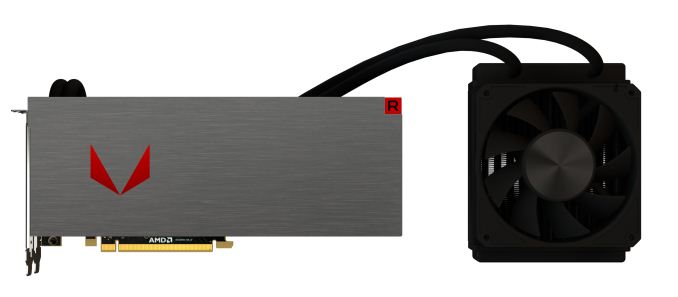
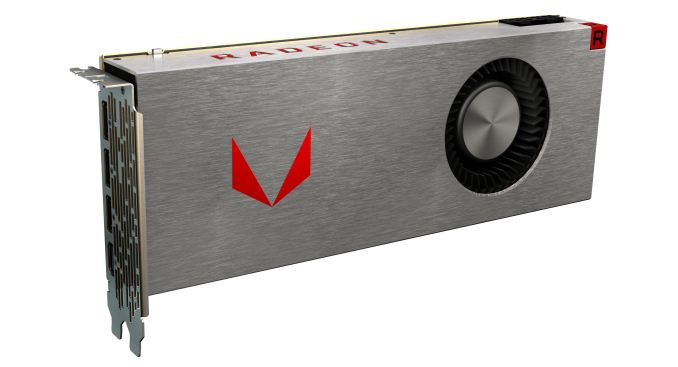

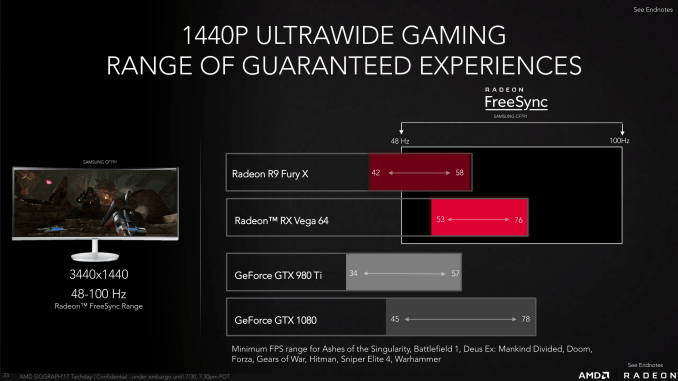
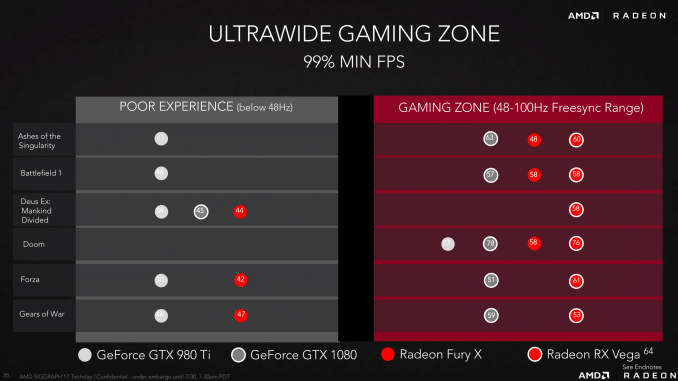








162 Comments
View All Comments
efficacyman - Monday, July 31, 2017 - link
I also wish there was more clarity on SR-VIO. If it is enabled and supported on consumer cards I will be definitely buying Vega.siberian3 - Monday, July 31, 2017 - link
Well to beat Nvidia in my opinion they need to keep their power draw in check so we have:1.RX VEGA 56 against 1070 or 210W power draw Vs 150W power draw
2.RX VEGA 64 against 1080 or 295W! power draw Vs 180W power draw
Also they are 1 year late to the game.Nvidia will have Volta early next year (probably) dont see AMD are in a good position with this generation and i dont think Navi will save them either which is always bad for us consumers
Nagorak - Monday, July 31, 2017 - link
It's really a moot point by now. Nvidia hasn't had any competition at the high end for 2 years now. We're already getting fully gouged. The only thing holding prices in check is what the market will bear.mapesdhs - Wednesday, August 2, 2017 - link
Nobody's getting gouged. If you don't like the pricing, don't buy the product. Sick of reading this pseudo-commie nonsense, when really it's just wealth jelousy in disguise IMO (either that or people just don't want to take responsibility for their purchasing decisions).apple020997 - Monday, July 31, 2017 - link
Hmmmmmmm, let’s try to be objective.All AMD tests are made with the worst version of Vega 64. This means that the card will be always near the lower end of its clock range (or worse, throttling).
So, based on that, AIB versions with better coolers (or, as I’ll do, stock cards with a waterblock slapped on them as part of a 2x240 custom loop) will be faster, and (I hope) by a good margin. And don’t forget the better drivers (as AMD always releases)
YazX_ - Monday, July 31, 2017 - link
OK, Pascal refresh is coming next year, no need to release VOLTA as Nvidia is still ahead, sigh....Lolimaster - Monday, July 31, 2017 - link
Not anyone wants ultra wide screen monitors. Samsung should scrap the annoying curve and release a 24-27" VA 144Hz Freesync FG70. Also rebates on 500-1TB samsung EVO/Pro.R3MF - Monday, July 31, 2017 - link
No. They should not do that.Nagorak - Monday, July 31, 2017 - link
The curve isn't really noticeable once you get used to it. I think it may actually be a plus in games. It's basically a non-issue in every other situation.damianrobertjones - Monday, July 31, 2017 - link
Nah. A curved screen is only good for one thing... Marketing finding another way to sell you something new. I tried, honestly, I really tried to find a realistic positive to a curved screen but found nothing concrete.